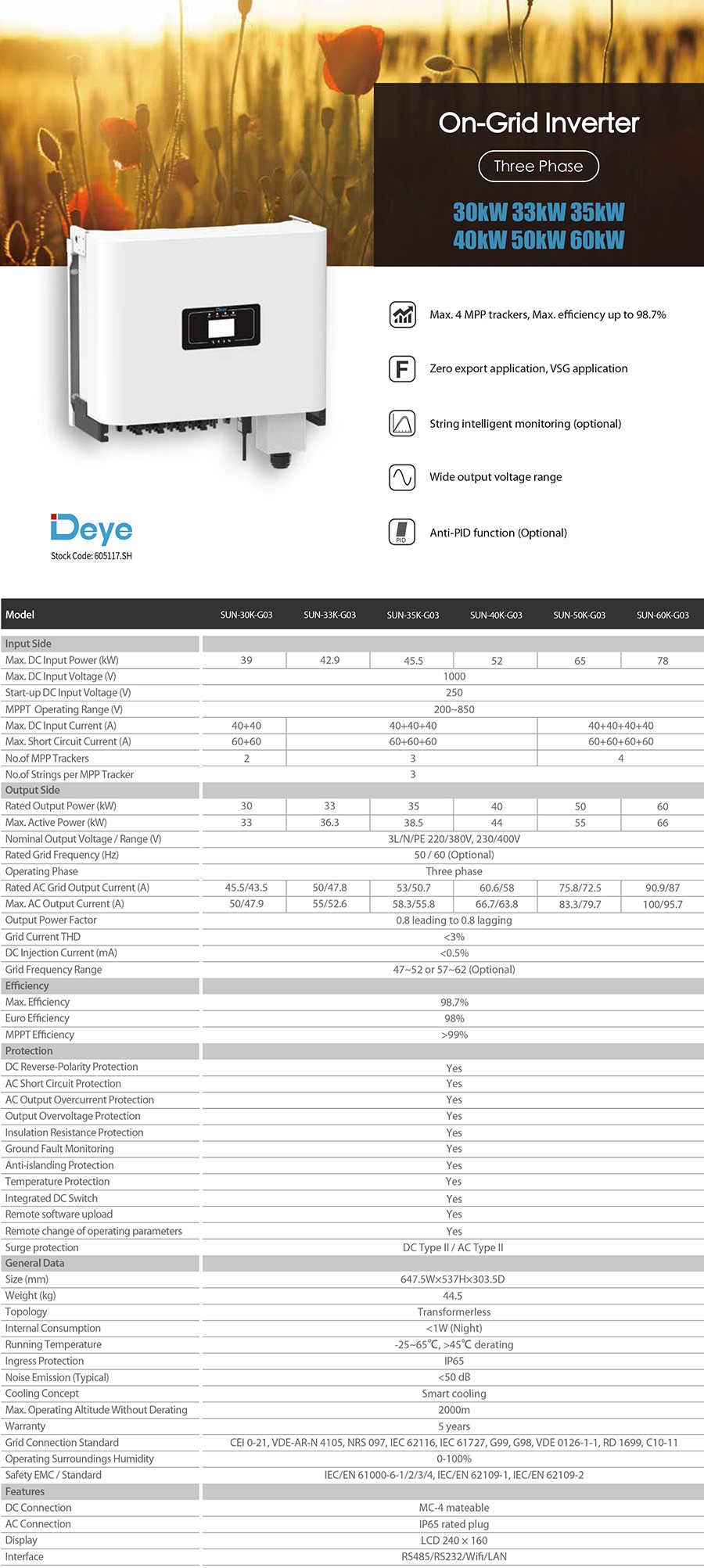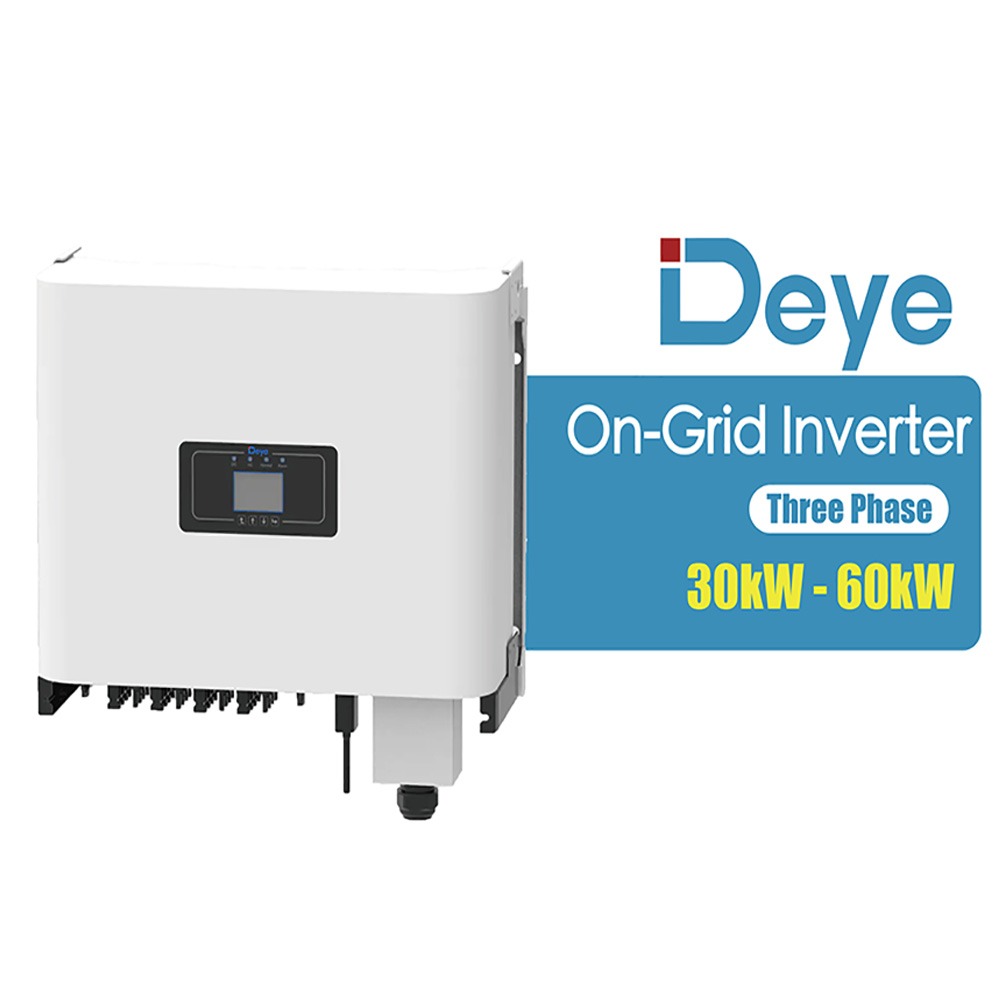| On grid solar inverter 30kW, Three Phase |
| Power: 30kW 33kW 35kW 40kW 50kW 60kW |
| Warranty: 5 year |
| Brand: Deye |
Deye On Grid Solar Inverter 30kW 35kW 40kW 50kW 60kW
Description

On grid solar inverter 30kW
Understanding the Differences Between Deye’s 30kW, 33kW, 35kW, 40kW, 50kW, and 60kW On-Grid Solar Inverters: Regional Suitability and Varied Returns
Deye’s range of On-Grid Solar Inverters, spanning power capacities from 30kW to 60kW for three-phase systems, offers a diverse set of options for solar energy installations. These inverters are engineered to cater to a wide spectrum of applications, and their performance and returns can vary based on geographical location and specific energy needs. In this comprehensive guide, we will explore the distinctions between Deye’s 30kW, 33kW, 35kW, 40kW, 50kW, and 60kW On-Grid Solar Inverters, considering their suitability for different regions and how regional factors may influence returns on investment. On grid solar inverter 30kW
Differences Between Deye’s High-Capacity On-Grid Solar Inverters:
- Power Output: The most apparent difference among these inverters is their power capacity, ranging from 30kW to 60kW. Higher-capacity inverters, such as the 50kW and 60kW models, are designed to handle larger energy loads and accommodate more extensive solar panel arrays.
- Energy Production: In regions with ample sunlight, higher-capacity inverters can yield more electricity, potentially leading to increased energy production. The suitability of a particular capacity depends on the solar irradiance of the location. On grid solar inverter 30kW
- System Scalability: When planning a solar installation, it’s crucial to consider future scalability. Higher-capacity inverters allow for greater expansion, making them suitable for applications where future energy needs may grow. On grid solar inverter 30kW
- Grid Compatibility: Depending on the electrical infrastructure and grid requirements of a region, different power capacities may be more appropriate. Consultation with electrical experts is essential to ensure grid compatibility.
- Space and Installation: The physical space available for solar panels and inverters can influence the choice of capacity. Higher-capacity inverters may require more installation space.
- Financial Considerations: The cost of the inverter, solar panels, installation, and potential financial incentives can impact the choice of capacity. Higher-capacity inverters may offer cost advantages for larger installations. On grid solar inverter 30kW
Regional Suitability and Varied Returns:
- Solar Irradiance: Solar irradiance, or the amount of sunlight a region receives, plays a significant role in energy production. Regions with higher solar irradiance, such as sunnier climates, can benefit from larger capacity inverters like the 50kW and 60kW models.
- Geographical Location: Geographical factors, including latitude and climate, affect solar panel performance. In regions with consistent sunlight, higher-capacity inverters may lead to more substantial energy generation.
- Energy Demand: Consider the energy needs of the specific region or application. In areas with high energy demands, a larger inverter capacity may be necessary to meet those needs efficiently. On grid solar inverter 30kW
- Grid Connection: Local grid infrastructure and regulations can influence the choice of inverter capacity. Ensure that the selected capacity complies with grid connection requirements.
- Financial Incentives: Investigate available financial incentives, rebates, and tax credits for solar installations in the region. These incentives can significantly impact the overall return on investment.
- Local Regulations: Be aware of local regulations and requirements regarding inverter capacity and solar installations. Compliance with these regulations is essential.
Conclusion:
Deye’s range of On-Grid Solar Inverters, spanning from 30kW to 60kW, offers versatility and adaptability to accommodate varying energy needs and regional conditions. The choice of inverter capacity should be based on a comprehensive assessment of factors such as solar irradiance, geographical location, energy demand, grid compatibility, financial considerations, and local regulations. Ultimately, the suitability of a specific capacity will vary from one region to another, and careful planning is crucial to maximize returns on investment. Whether you opt for a 30kW, 33kW, 35kW, 40kW, 50kW, or 60kW inverter, Deye’s high-capacity offerings are designed to provide efficient, reliable, and sustainable solar energy solutions for diverse applications worldwide.





